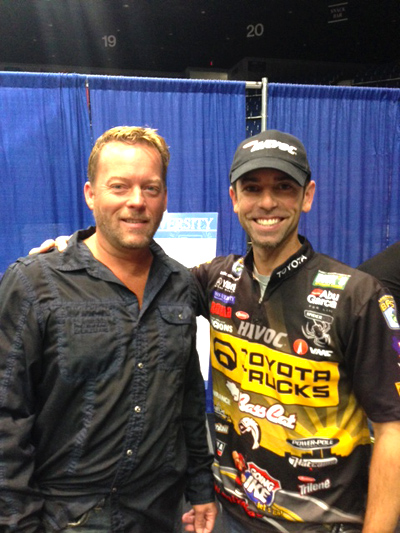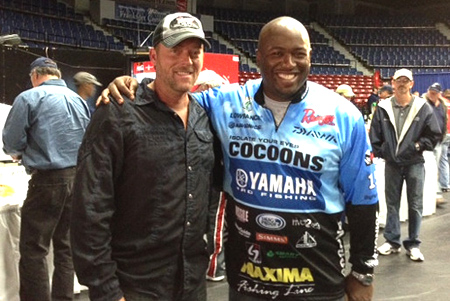
By Chris Erwin
With forty years of fishing under my belt and 25 years of fishing the club circuit, I have always been interested in new developments in the art of bass fishing, while I didn’t get to attend this event on Jan.19th -20th In Frankfort Ky, we did have one of Kentucky Angling members attend.
Scott Doan from Morehead KY, has been a faithful contributor to the fishing community his fishing skills become easy to recognize as he post fishing reports regularly, he has the skill and convenience to compete on almost any level. His impression of the Bass University is a valued collection of information that anyone serious about bass fishing should be interested in.
As we talked about his experience, I felt it would be a good idea to share with you his notes and thoughts about this two-day event.

The first words he had to say…”Wow … what a great series of seminars by some exceptional fisherman!! Even more impressive than their knowledge base was their willingness to share information. Truly, a credit to their sport and they really seemed to get along well on and off the stage. Understand of course that these guys are sponsored and many of the specifics they give are relative to their sponsored baits”.
Q: Scott did you take notes that you can share with us.
A: “Yes, Here are some of my takeaways from the seminars. Keep in mind I only took notes on the items that I didn’t know or wanted to remind myself of. Everyone takes back different things from a seminar so these are just mine, but I can assure you they covered much more. You’ll also note I took many more notes from Iaconelli’s seminar. He just matched up more with things I was looking for as well as had items I didn’t know or hadn’t thought about”.

Mike Iaconelli
“He spoke about the process of finding fish. His process starts with researching the lake from home. Call the local tackle shop … Google earth … Internet searches … ask friends … but find out as much as you can from home.
Look for things like the average winning weights … which parts of the lake are most productive … what lures are known winners on this lake. The “parts” of the lake are important because you don’t want to try to fish the whole lake; however, you want to fish one area well.
Once you break the lake down to an “area” you intend to fish … print out or retrieve a map. From here take out a black, red and blue marker. With a blue, pen circle probable winter spots on the map. Bass will winter in deeper water on the most vertical breaks on that “area” of the lake.
(Special note … if grass stays green they will stay there year round) Obviously the vertical type breaks will be noted by contour lines that are very close together.
Next take your red pen and circle probable spawning coves. Remember they want areas protected from the north wind … hard bottom … and prefer some sort of structure such as logs, stumps or base of grass.
Now with the black pen … connect the dots! Start at the blue circle and follow the contour lines back to the nearest spawning cove. Along the way circle any stopping spots or points that appear on the map.
Some points will be submerged … some exposed … a dock; tree … all could be stopping points.
Once you have these spots marked you simply need to apply the season! If it’s early March, you know they will be somewhere between the winter spots and the front 1/3 of the coves/arms leading to spawning flats.
Fish the circles you made on the stopping points. If it’s May … the front 1/3 to the back of the coves … etc. A dock could serve as a stopping point depending on where it is on the route, but you won’t see things like this until you get on the water. Last step is to get on the water and fish those marked areas, looking for the spots within the spots”. (Small rock pile … log … change)
Additional points from his session:
1) Summer fish want deep water, current or thick cover. In the heat of summer, some big fish will stay shallow if the cover is thick enough.
2) Early Fall … fish will head shallow often times stopping on the same points they did when heading shallow to spawn. Finding bait is most important in the fall! In the fall, you also want to target “hard” objects … trees, rock, etc. If you find coves with fresh water entering in the back they will typically be better than coves that do not.
3) When you are on the water to check the spots, you circled … key on those spots that change. Transition of bottom composition … deeper or shallower spots … structure … etc. When fishing these areas you are not fishing for fish as much as to determine the bottom so fish Carolina rigs … crankbaits or jigs. Catching a fish is a bonus … but you want to save those for your tournament.
4) Always go into a tournament after pre fishing with at least two patterns … but preferably three. Things change during the tournament, and you need to be prepared to adapt.
5) When fishing a crankbait … it’s all about deflection and change. Bounce the lure off anything you can include wood, structure … the bottom. It’s the change in movement that triggers the bite. If you have nothing … constantly change your retrieve speed and include stops and jerks.
6) When establishing a pattern remember everything you can about that first fish you catch (and all others) but at least make a mental note of the depth … speed or action of retrieve … and what type of structure.
Brent Ehrler
Sonar & Side Imaging
1) The lines that show approximately 30 degrees angles from bottom to top are typically bubbles.
2) Fish appear as arches on 2D graphs only when moving. When stationary or moving very slow they appear as longer horizontal lines.
Drop Shots:
1) Typically uses 1/4 oz, weight or a 3/8 oz. weight when a little windy.
2) Thin Senkos are good. If you are around smallmouth …Gulp Minnows are hard to beat.
3) Typically a vertical presentation and adjusts his electronics to see his sinker and bait as he drops it. (keep the bait above the fish on your screen)
Ott DeFoe
Look for floating debris you want to punch mats of (saw dust … branches … leaves, etc) in early spring when the water gets around the mid 50s. Ideal when the water is coming up but not dirty and obviously best in the sun. Find pockets where the wind has blown this debris in … water depth should be 5′ or less under the mat.
Pete Gluszek
Crankbaits
1) If the bill is pointed down it has a wide wobble. (better in dirty water)
2) If the bill is pointed straight out, it has a tight wobble. (better in clear or cold water)
3) Rounded bills are better for grass.
4) Square bills are better for hard targets (rock … wood)
5) Bass will typically spawn on the inside edge of a grass line.
When fishing is tough or you have docks … drop shot a wacky rig Senko.
John Crews:
Shakey Head
1) After you have located fish with a crankbait; spinner bait, etc., turn around and hit that bank/structure again with a shakey head to pick up the rest of the fish.
2) The least action on a shakey head … the better. Slowly raising the rod tip allows a football head shakey head to “stand up.” up”. You want to move it as little as possible … especially once you reach the structure. Sometimes all you need is tension on the lure with no other action.
When to crank … you need overcast skies and preferably wind if you are in clear water. Stain water you don’t need that and is ok in the sun.

Ish Monroe
Frogs
When the morning water temp reaches 52-54, it’s time to start throwing frogs. Don’t be scared to skip frogs under docks.
Best time for big swimbaits is from pre spawn (47 degrees) all the way up to 70 degrees. When it feels like a fish is preparing to spawn they want a big meal that requires less work.
Scott goes on to tell me that about 70 people attended,(a guess) it was a classroom setting. However, before lunch the pros would split out into separate tables in the back of the room, and you have the opportunity to go to which ever table you wanted and ask whatever you wanted.
“An awesome opportunity to for you to speak one on one with one of the pro’s about any of your specific needs. In addition … as we went to breaks, we could corner whoever was around, and they were free with their information. You could also ask questions at any point during their seminar, and they all had a question and answer session at the end of their sessions”.
The bass University will be holding classes across the country and for more information, you can visit their website http://www.thebassuniversity.com the advertised cost is $199 for the two-day event for adults this does not include lodging, $99. For Saturday or Sunday only and $175. For students under 17 or $87.50 for students under 17 for one day.


Be the first to comment